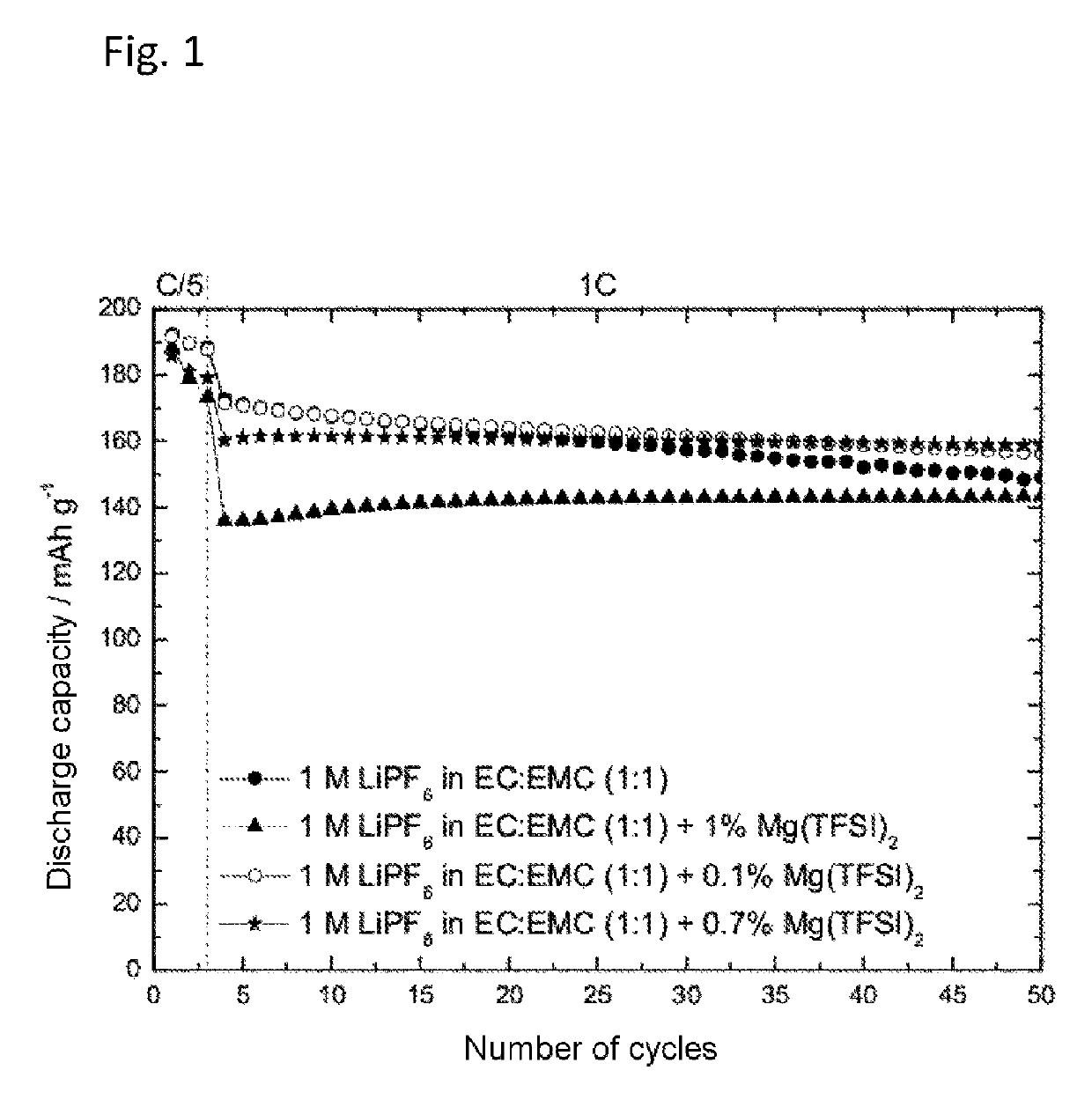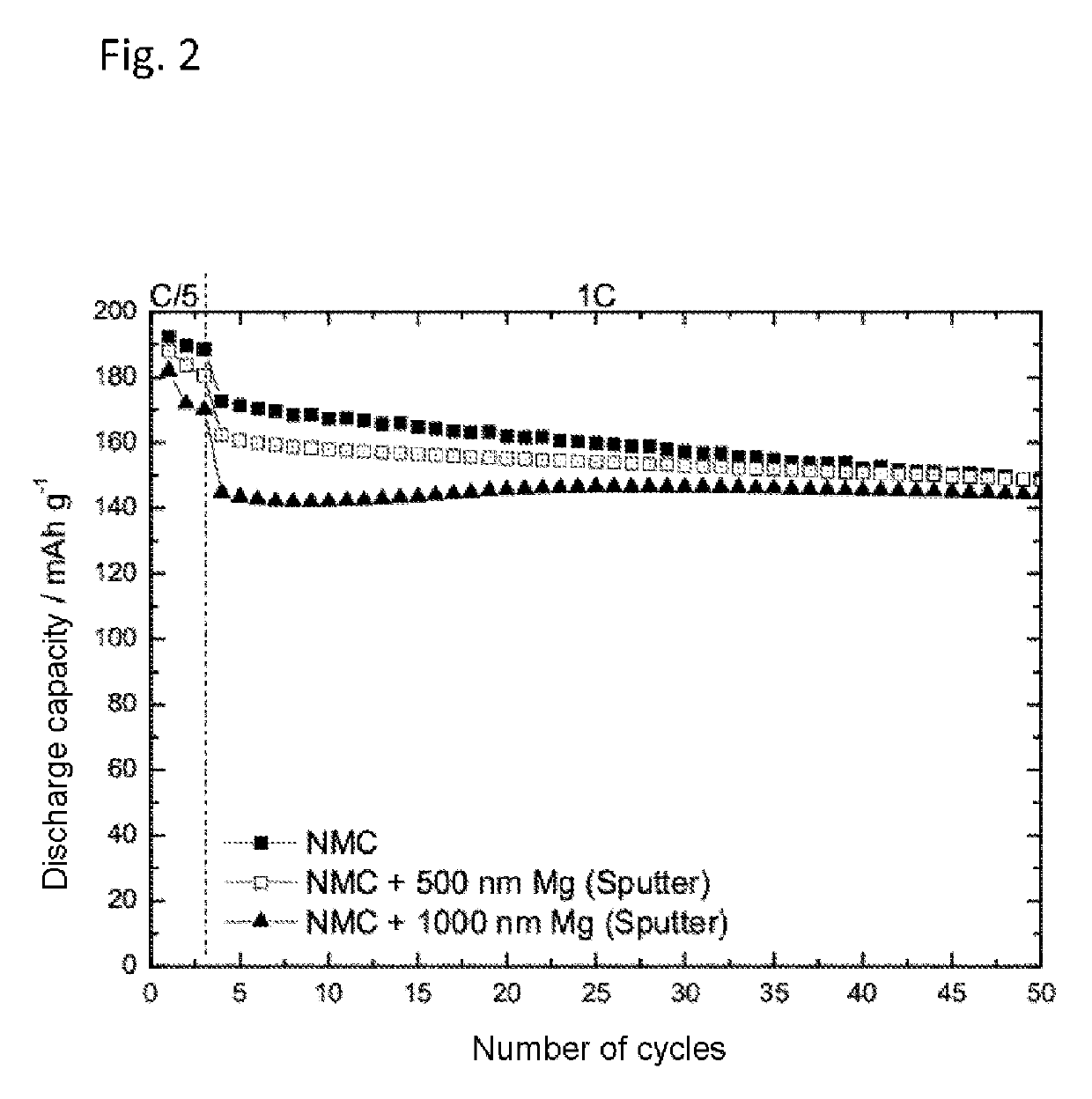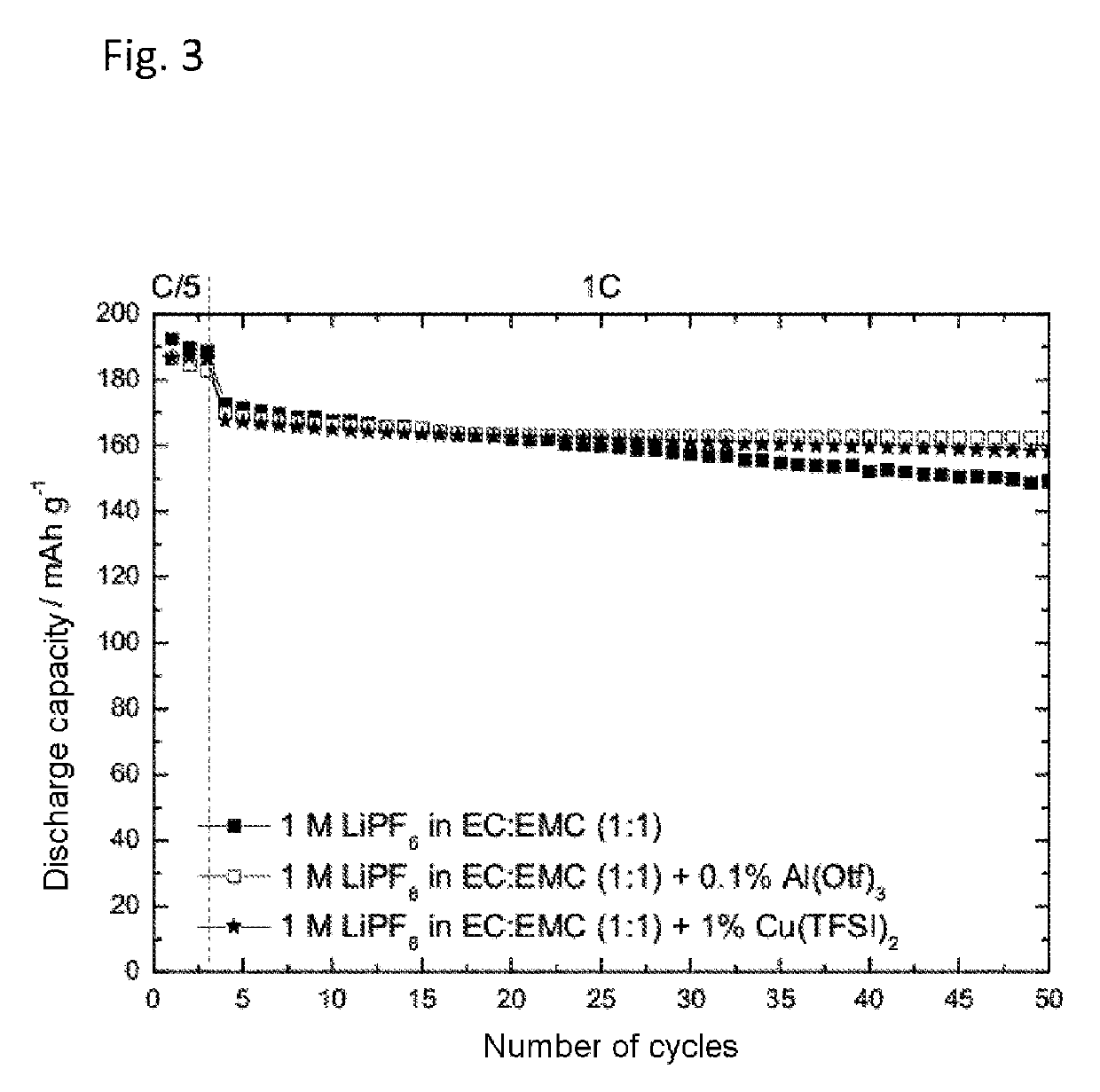Electrolyte additive and metal included in composite electrode containing Mg, Al, Cu, and Cr for alkali metal storage system
a technology of alkali metal storage and additives, applied in the field of alkali metalbased, can solve the problems of low oxidative stability of 4.5 v against li/li+/sup>, low cycling stability, etc., and achieve the effects of improving the compatibility of electrode and electrolyte, reducing the capacity attenuation of the lithium energy storage system, and increasing the end-of-charge potential
- Summary
- Abstract
- Description
- Claims
- Application Information
AI Technical Summary
Benefits of technology
Problems solved by technology
Method used
Image
Examples
example 2
[0058]Determination of the Cycling Behavior of Magnesium(II) bis(trifluoromethanesulfonyl)imide in an NMC Half-Cell:
[0059]The preparation of an electrolyte containing 1 M lithium hexafluorophosphate (LiPF6) in a solvent mixture of ethylene carbonate and ethyl methyl carbonate (EC:EMC 1:1) with addition of 0.1 wt %, 0.7 wt % or 1 wt % of magnesium(II) bis(trifluoromethanesulfonyl) imide (Mg(TFSI)2), and also of a comparative electrolyte without addition of Mg(TFSI)2, took place as described under Example 1. The cycling behavior was determined using an NMC half-cell at constant current as described above.
[0060]FIG. 1 plots the discharge capacity against the number of cycles of 1 M LiPF6 as solvent mixture of ethylene carbonate and ethyl methyl carbonate (EC:EMC 1:1) with and without addition of magnesium(II) bis(trifluoromethanesulfonyl)imide (Mg(TFSI)2) in an NMC half-cell. As FIG. 1 shows, the addition of Mg(TFSI)2 reduced the drop in the discharge capacity with increasing number of...
example 3
[0061]Determination of the Cycling Behavior of Magnesium-Sputter-Coated NMC:
[0062]a) Production of Magnesium-Sputter-Coated NMC Cathodes
[0063]Thin-layer magnesium dots were deposited by means of RF magnetron sputtering, using a 2-inch magnesium target, at a power of 30 W. In order to produce a dot pattern (3 mm, 2 mm, and 1 mm diameter), the NCM coated substrate was provided with a correspondingly perforated mask. The base pressure of the high-vacuum unit was 5×10−8 mbar. At a working pressure of 5×10−3 mbar, argon was used as process gas. Through the simultaneous coating of silicon wafers, the layer thickness of the magnesium dots was determined by profilometry. This layer thickness was determined as 500 nm or 1000 nm in each case for two cathodes.
[0064]b) Determination of the Cycling Behavior
[0065]The preparation of an electrolyte containing 1 M LiPF6 in a solvent mixture of ethylene carbonate and ethyl methyl carbonate (EC:EMC 1:1) without addition of Mg(TFSI)2 took place as desc...
example 4
[0067]Determination of the Cycling Behavior of Copper(II) bis(trifluoromethanesulfonyl)imide and Al (III) Trifluoromethanesulfonate in NMC Half-Cells:
[0068]The preparation of the electrolytes containing 1 M LiPF6 in a solvent mixture of ethylene carbonate and ethyl methyl carbonate (EC:EMC 1:1) with addition of 0.1 wt % of Al(III) trifluoromethanesulfonate (Al(Otf)3) or 1 wt % of copper(II) bis(trifluoromethanesulfonyl)imide (Cu(TFSI)2) took place as described under Example 1. The cycling behavior was determined in an NMC-half cell at constant current as described above.
[0069]FIG. 3 shows the discharge capacity against the number of cycles of 1 M LiPF6 in EC:EMC (1:1) with and without addition of Cu(TFSI)2 and Al(Otf)3 in an NMC half-cell. As can be seen from FIG. 3, the addition of Cu(TFSI)2 and Al(Otf)3 reduced the decrease in the discharge capacity with increasingly number of cycles (capacity fading).
PUM
| Property | Measurement | Unit |
|---|---|---|
| voltage | aaaaa | aaaaa |
| decomposition temperature | aaaaa | aaaaa |
| diameter | aaaaa | aaaaa |
Abstract
Description
Claims
Application Information
 Login to View More
Login to View More - R&D
- Intellectual Property
- Life Sciences
- Materials
- Tech Scout
- Unparalleled Data Quality
- Higher Quality Content
- 60% Fewer Hallucinations
Browse by: Latest US Patents, China's latest patents, Technical Efficacy Thesaurus, Application Domain, Technology Topic, Popular Technical Reports.
© 2025 PatSnap. All rights reserved.Legal|Privacy policy|Modern Slavery Act Transparency Statement|Sitemap|About US| Contact US: help@patsnap.com



